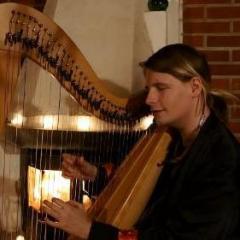-
Posts
3,729 -
Joined
-
Last visited
-
Days Won
15
Profile Information
-
Real Name
Wes M.
-
Location
Mesa, AZ
-
Occupation
Print Specialist
Contact
- Personal Website
Artist Settings
-
Collaboration Status
3. Very Interested
-
Software - Digital Audio Workstation (DAW)
FL Studio
-
Composition & Production Skills
Arrangement & Orchestration
Mixing & Mastering
Synthesis & Sound Design -
Instrumental & Vocal Skills (List)
Piano
Recent Profile Visitors
Emunator's Achievements
-
I'm going to put this one out of its misery quickly, since I know the twins are already looking to revisit this. The mixdown and especially the mastering feels incomplete and doesn't do justice to your fantastic arrangement, I know you guys can nail it better than this. See you on the other side! NO (resubmit)
-
The stereo spread on this is wild, it feels very intentional and meticulous even if it's not. The more heavily reverbed elements work with the more dry kit instruments in a way that I wouldn't have expected. I don't have any constructive criticism to add beyond what you already know and what's already been mentioned, but you gotta finish this guy! YES (please)
-
 Cyril the Wolf reacted to a post in a topic:
OCR04632 - Mega Man Battle Network "Mega Jam Disco Network"
Cyril the Wolf reacted to a post in a topic:
OCR04632 - Mega Man Battle Network "Mega Jam Disco Network"
-
 pixelseph reacted to a post in a topic:
Mega Man X3 - Blizzard Buffalo Stage (The Frozen City) ReMix: "Sorrowful Bellows ~ An Ode for a Winter's Night"
pixelseph reacted to a post in a topic:
Mega Man X3 - Blizzard Buffalo Stage (The Frozen City) ReMix: "Sorrowful Bellows ~ An Ode for a Winter's Night"
-

*NO* Super Mario Bros. 3 "Orchestral Variations on 'Overworld 2'"
Emunator replied to Emunator's topic in Judges Decisions
I'm going to quickly close this one out because I think the above three judges did a fantastic job expressing what works and doesn't work about this track. I love the studious approach to iterating a theme in as many different styles as possible, and keeping it cohesive along the way. But the orchestral programming needs a ton of polish to make it sound more like it was performed by an actual orchestra, rather than just a series of instruments being played off of a MIDI file. I will also add that there's some very massive dynamic jumps in terms of volume. Obviously, some degree of that is warranted, given the shifts in styles, but your quiet parts get REALLY quiet, and it doesn't sound intentional. You can still achieve this effect without requiring the listener to actively engage with the volume slider throughout the song in order to maintain a comfortable listening experience. This can start with normalizing the volume levels and automating them in certain parts, and can be further balanced out with some subtle compression on the master channel. There's so many great ideas here, but this feels like a draft rather than a polished production - I do hope we see this back someday! NO (resubmit!) -
Additional ears? You got it. I'm coming in cold on this one so you're going to get all of my impressions - not saying that all of this needs to be addressed to pass a resubmission, but hopefully you can make use of the brain dump. The intro brings some really cool flavor - the noisy distorted elements remind me of Porter Robinson's Fellow Feeling (see the 3:00 mark if you're short on time.) If you're going for random blasts of noise, I think this works - if you're trying to make it sound like footsteps stomping through, it's not giving that impression at all because every stomp is exactly the same. There's no variation in the sample and it reaches uncanny valley territory fast when you play the sample multiple times in a row. This all boils down to what you are going for here, but either way, I think some subtle variation with each repetition of the sample/layer of samples (without knowing how you actually did this) would build immersion. Some of your orchestral elements (flute, glock) are very resonant, oftentimes peaking at their fundamental frequency between 3-6db above everything else. The bells in the intro also feel comparably dry. This will probably get ironed out in your next pass, but I'm going to point it out anyway. The orchestral sequencing sounds workable for the most part, you're getting good mileage out of your samples. It's not the best but I do think you're using them effectively for the most part - the main areas that sound really noticeably fake are the half-step chromatic runs on the strings at times like 2:48. I just don't think the big ensemble patch moves fast enough to accommodate that writing, and would recommend adjusting the lead writing to fit better within the limitations of your samples. I also feel like the intro could use some deeper sub bass presence. It's not that the stomps aren't contributing any bass frequencies, but a big cinematic sub drop or sustained bass to accompany the stomps (see Fellow Feeling) would make this feel much more dynamic, or have some risers building up tension in the low end leading into :49. The decision to intersperse various melodic elements (glock, harmonic strings, cello) was a good one - otherwise, this intro would be way too long. It already feels a bit lengthy as-is, but those additions help pad it out quite a bit and justify the length. However, this gets to the problem of transitions and buildup, which I think is my biggest gripe currently. There is rarely much going on to signal that we're approaching a new musical idea, so even though you have some very dramatic changes throughout your arrangement (which are quite inspired and interesting, I must add!) they come on very suddenly. Cinematic risers, fills, sweeps, etc. are a part of this equation and could definitely be used to greater effect here to bridge your gaps, but there's another element I want to touch on: the idea of movement in your part writing. You do a great job building atmosphere and have all the makings of a very dramatic song, but there's a lack of movement on a compositional level. When cinematic music is clicking well, composition and sound design have a lot of synergy. Right now, you are doing a good job building an interesting sound palette for each individual section, but the underlying chord progression feels weak. It hovers around the tonic chord for most of the time, and even when you do have chord changes, they don't feel properly supported with anything strong in the lower frequencies. This is where a bit of music theory troubleshooting could go a long way - your melody has many opportunities for powerful chord movements that build drama and tension, especially as you lead into new sections, but you're not fully capitalizing on that potential. I don't think it would even require changing up much fundamental about the rest of the parts; just identify the chord progression you're playing and make sure that there's strong support in the bass for whatever chord/root note you're trying to play. I don't know how else to suggest addressing this without studying up on some fundamentals of music theory, but certain chords just move naturally into others and can help you allude to future changes and help transition between vastly different musical ideas in a way that feels rewarding. I think you're running up against some of the same problems I faced before I made the decision to finally start researching music theory. I had a conceptual idea in my brain for what each section of my song was supposed to do, and could support it in terms of selecting sounds and picking grooves/effects/etc., but it boiled down to luck whether or not it worked on a fundamental composition level, and I spun my wheels trying to fix that issue with every other production tool known to man. I think if you were to pick an area to focus on, the big orchestral section starting at 2:36 would be where I'd focus my energy most. Everything else before and after that can skate by a little easier, but when you're trying to make a big melodic orchestral statement, the fundamentals need to be strong first. Figure out what chord you're playing on each measure and map them out in sequence using just a basic patch. I find that it helps to actually just plot my chord progressions out on piano so there's no temptation to get distracted by sound design. See if the song sounds strong and compelling when it's just played on a single instrument, and go from there.
-

OCR04643 - *YES* Diablo "Diablo Has to Synth"
Emunator replied to Emunator's topic in ReMix Reviews & Comments
The analog wobble is real! There's certainly a great deal of resonance in the filter envelopes on these synths, but overall I found this to be a smooth set of sounds - because the overall mixdown was balanced with a hefty bass synth that filled out the frequency spectrum, the overall feel of the mix was totally sufficient for me. I'm seeing mud called out in other votes, but again, it feels more like deliberate warmth and less like a mixing-level oversight. The ending fizzled out, but what are ya gonna do? The arrangement has already been covered at length so I'm not going to dwell on it, but in my book, the arrangement approach is fine. The expansion in sound design keeps the first half of the track engaging so that even though it's compositionally conservative, there's something new being offered from the jump, and then you get into more engaging territory with the arrangement as well to round things out. It's a bit unconventional but I don't see any problem with it, and I personally enjoyed listening to this quite a bit! There's a lot to get lost in. YES -

OCR04632 - Mega Man Battle Network "Mega Jam Disco Network"
Emunator replied to Liontamer's topic in ReMix Reviews & Comments
Insanely good track to everyone involved, this is the kind of music I want to be making. Y'all are nuts. -
 Emunator reacted to a post in a topic:
Welcoming some new staff members!
Emunator reacted to a post in a topic:
Welcoming some new staff members!
-
 Fgg reacted to a post in a topic:
Seeking musician for Donkey Kong Country style game [Commission]
Fgg reacted to a post in a topic:
Seeking musician for Donkey Kong Country style game [Commission]
-

Seeking musician for Donkey Kong Country style game [Commission]
Emunator replied to Fgg's topic in Recruit & Collaborate!
Resident Donkey Kong Country fanboy here, sending you a DM :) -
 MessagesFromEarth reacted to a post in a topic:
OCR02071 - Final Fantasy IV "Everclear Hangover IV"
MessagesFromEarth reacted to a post in a topic:
OCR02071 - Final Fantasy IV "Everclear Hangover IV"
-

OCR04622 - Xenogears "Back to the Sea, Black to the Fire"
Emunator replied to Liontamer's topic in ReMix Reviews & Comments
Alright, so this might be a first - due to a misunderstanding, both Larry AND myself did full writeups for this submission without knowing it! So, here's my full commentary, now in review form! :D H36T continues his hot streak of modern cinematic reimaginings of classic JRPG themes, this time with a dramatic take on “Bonds of Sea and Fire” from Xenogears that leans into the idea of contrast on multiple levels. Although the final product that you’re hearing now is pristine and polished, the process wasn’t as straightforward as the end result might suggest - it took a lot of blood, sweat and tears to get here. I’ll let the artist explain: “Given everything I've learned since I've made this song, it sort of pains me that I can't revisit it easily. The original file is lost to the ether and while I could try and recreate some of it and do some new things here and there...some things are best left in the past and its time to move forward. Thus we come to this song, which if you know anything about Xenogears, sort of represents the past itself. The approach I used is mostly straightforward and adding pieces here and there that represent me as a musician and my influences. In that way, there is my past wrapped up in this song as well. The second half adds some newer elements and I see this as more of the "fire" to the first half's "sea." The end...is a bit unfortunate and I wish I could go back and fix some things and change others. But as with the past, there is no fixing this guy and he is who he is. So as god once said, "come as you are." and as such, I bring "Back to the Sea, Back to the Fire" for judgement! Maybe this old dog of a song will teach me some new tricks through evaluation.” Astute listeners may have picked up on the fact that, despite the submission letter suggesting that the project file was lost to the sands of time, what you’re hearing now is actually a resubmission. The first iteration was initially rejected by the judges panel, albeit in a split decision, with the majority of judges taking issue with the overall conservative nature of the arrangement, especially in the first half, as well as the “choir practice” at the end of the arrangement feeling detached from the rest of the piece. These are all critiques that H36T himself preemptively called out in his own submission letter, but after the first rejection, he dug deep within himself and his hard drive and was able to recover the long-lost file to take another stab at it. Nearly a year later, we got a revised version addressing the criticism from the first submission: “Another year, another resub! I've been pretty good so far at taking a second look at things and trying to correct errors and be more creative. Let's see if I can accomplish the same here. Funny story, in my original submission, I misspelled my own track. However, I actually liked the typo better! Something about blackening over the fire sounds cool. Anyway, though I thought I lost this track, it was sitting out in the open named something completely different. Unfortunately, that meant another track was lost LOL. Seeing as I don't know what track that was....I'm not too sad about it. As far as the update is concerned, I reworked the ending to be more related to the song at hand and added a bit more flavor in the middle. There are some technical mishaps here and there I'm sure but I'm not sweating them. Here is hoping you like this updated version! Until next time.” A little goes a long way here - the extra personalized touches really add a lot to the first half of the arrangement, such as the lush vocal padding, tasteful orchestral percussion fills, or the hint of tension between the flute and choir at 1:37 that alludes to the more overt dissonance that appears at 2:15 and 3:11. All of these minor additions keep the first half fresh; even though H36T plays it close to Mitsuda’s original source material, you can still feel the artist’s personal touch coming through. Around the halfway mark, we dive into a more personalized, dramatic approach featuring more original flute riffing and a very cinematic-sounding supporting string section. We finally wrap up with a grand cinematic swell of strings, choir, and flute that teeters on the edge of falling apart but ultimately finds a satisfying resolution in the end (the metaphor really writes itself here.) The contrast between original and source material, tonal and dissonant elements, relaxing and dramatic moods – between sea and fire, if you will – all adds up to a result that respects the intention of the original Bonds of Sea and Fire, while also taking it to a level that simply wouldn’t have been possible on the original PS1 hardware. On a personal level, I have to commend H36T for his persistence and willingness to approach feedback with humility and grace. Putting yourself in a position to receive intense criticism on a piece that you’ve poured your heart and soul into that ultimately results in a binary “yes or no” vote can be intensely vulnerable. However, he’s consistently proved willing to take that feedback in good faith and channel it toward becoming a better musician, while also not sweating the small stuff in the end. To me, this ReMix is a case study in what makes a successful resubmission - humility, persistence, self-awareness, and a little bit of luck all played a factor here and I hope other budding artists take note! -

OCR04662 - *YES* Aquaria "Underwater Caves"
Emunator replied to Liontamer's topic in Judges Decisions
I definitely voted on the original submission but I don't recall it very clearly, so I'm going into this resubmission essentially with fresh ears. The intro hits us immediately with some tense, brooding analog buildups. The bass frequencies feel sparse and underpopulated but it leaves room to grow off of, and could easily be chalked up to a stylistic decision. I'm just used to hearing cinematic tracks like this with a bigger sub presence. Many of the synths and individual elements feel exposed and I can't help but feel like some sustained drone/ambiance used throughout the piece would help make this much more rich. At 2:15, the soundscape starts to flesh out and I'm feeling this more - it's a slow burn, but we got here. Your sound selection across the board is pretty great, feeling modern and in-line with Aquaria's aesthetic, but bringing some of your own flair to the table as well. It's simultaneously retro and modern. I do recall the previous submission feeling quite aimless in terms of arrangement, so I'm happy to say that doesn't seem to be the case here. The dynamic curve is much more deliberate and makes for a much more cohesive experience. The spoken word interlude is great from a conceptual level, but the vocals feel far too loud and don't blend in with the rest of the sounds. They feel pasted on top, and this highlights a general issue I'm having with this arrangement: I don't think that reverb and other creative mixing effects were utilized effectively to glue all of your elements together. Take the delay tail on the word "Aquaria" at the end of the poem. It feels like you're trying to create an atmospheric delay throw, but because there's so little diffusion on your delay, it actually feels more like you're just looping the sample over and over again, and it breaks the immersion for me. This is tough for me - the arrangement and sound design are strong points here, but I still am left feeling underwhelmed by the atmosphere and immersion due to certain elements (specifically the vocals) feeling too loud and inconsistently mixed with the rest of the soundscape, and a general sense of sparseness in the mix due to limited bass frequencies and lack of padding elements. I do think this gets by on the strength of its arrangement and concept, but I still think there's room for improvement on future submissions if you approach this style again. YES (borderline) -
I hard-disagree with the idea of rejecting this on the grounds of the ending - I think it's fine and I've certainly heard the tape stop/record skip ending used in other contexts both in and out of the OCR sphere. "Mass of distortion" feels like a hyperbole compared to what I'm hearing, it's just some tape warble effects and saturation. That decision feels like like a stylistic decision to me, I'm very surprised to see this with a NO vote on solely that reason. Ending aside, this track represents a significant improvement over the original submission. This boasts a much fuller soundscape that better matches the production quality and richness of the material that inspired it. The drums could still stand to be a little more organic and humanized (most drum kits in this style were sampled from actual live breaks rather than sequenced, and there's certain times you can really tell that this was programmed in manually from one-shot samples) but it's lightyears ahead of where it was in the last version. Thanks to the revamped mixing, you can even hear elements like the wonderful vocla harmonies that, apparently, were always in the arrangement but never really grabbed my attention before. It's a vibe. YES
-
 Emunator reacted to a post in a topic:
OCR04431 - Super Mario World & Super Mario Bros. "First Jumps"
Emunator reacted to a post in a topic:
OCR04431 - Super Mario World & Super Mario Bros. "First Jumps"
-

OCR04671 - *YES* Octopath Traveler 2 "The Fountain of Doubt"
Emunator replied to Liontamer's topic in Judges Decisions
Not going to rehash the source usage debate at length, it checks out. I agree that the overall feeling of the production is flat, which is a shame because the arrangement is pretty dynamic and covers a lot of territory ranging from cinematic to synthwave to rock. The instruments and synths are all well chosen, but the overall mix doesn't really instill a lot of character into the parts you've written. Chimpazilla called out the lack of high end sparkle and I agree with this - some light tape saturation or an exciter on certain elements would bring back some warmth and character that this is missing, either on the master chain or at the mixbus level. In addition, the rhythm guitars feel almost pasted on, notably starting at 2:09. It almost feels like the rhythm guitars were sequenced with how rigid they are, which is a shame compared to the lead guitar which is far more expressive. I think this is something you'll look back on a year or two from now and hear a number of ways you could have improved this, but even in its current state, it's certainly serviceable! And the arrangement is very strong, so I have no problems passing in its current form. YES -

OCR04673 - *YES* Mario Kart 64 "Watery Graves! Majestic Views!"
Emunator replied to Liontamer's topic in Judges Decisions
Hot damn Michael. You know sometimes when you can't quite find the words for why something sounds amazingly produced, but you can feel it on a visceral level? That's what the production on this track does to me. Every single sound feels deliberately placed, and there's not a single space in the frequency spectrum that feels neglected or overemphasized. "Empty but full" is an absolutely perfect way to describe this, and I think you've made some tremendous strides in the quality of your mixing and mastering to help achieve this effect. The better frequency balance, spatial presence, and attenuation of harsh frequencies is absolutely felt here. I don't think it's an exaggeration to say that this sort of triumph simply wouldn't have been possible a year or two ago, and it speaks to the level ups that you've made as an artist in that time. Even the arrangement itself feels like it flows more naturally than some of your previous genre-bending mini-suite sound design experiments. Would it be going to far to even describe this as a pleasant listen? I don't think so. I'm not sure how you do it, but keep doing it. YES!!! -

OCR04667 - *YES* Final Fantasy 4 & 8 "Time Flies"
Emunator replied to Emunator's topic in Judges Decisions
Honestly, I hate you guys. I don't think I will ever recover - physically, emotionally, financially, spiritually - from the smackdown this track put on me in the first GSM competition. I put out what I consider to be one of the best pieces of music I've ever made, and you just stomped all over it with your stupid synthwave bleeps and psytrance bloops. It's perfectly viable to reject a track on the grounds that it hurts my ears, so why not on the basis of it hurting my feelings? NO ... ... fine. It's good. Really good. I find that the team atmosphere of GSM lends itself to tracks that can sometimes feel like a mashup of everybody's ideas, "executive boardroom style", and I can't say that this doesn't feel that way to an extent, but you exercised such a great level of creative control over the parts that you have that it absolutely works in this track's favor. It feels like an adventure, and psytrance is the perfect musical foundation for this kind of approach. It's a genre that relishes in its buildups, breakdowns, and unexpected hard stops and left turns, and man you've got a lot of them here. It helps that every section of the track is engaging and brings something new to the table, but you transition so expertly between them that the time just flies by [Editor's Note: I wrote this out unironically and forgot the name of the remix title. Any puns are entirely coincidental.] This absolutely does not feel like 6 and a half minutes long. A well deserved victory my friends! YES -

OCR04561 - Minecraft "Meditations on a Beam of Light"
Emunator replied to Liontamer's topic in ReMix Reviews & Comments
Wow, thank you all so much ? I made this track on a whim and needed convincing to even submit/publish it at all, I'm really pleased to see such a positive reaction to it. -
 Emunator reacted to a post in a topic:
OCR04561 - Minecraft "Meditations on a Beam of Light"
Emunator reacted to a post in a topic:
OCR04561 - Minecraft "Meditations on a Beam of Light"
-
 Emunator reacted to a post in a topic:
OCR04561 - Minecraft "Meditations on a Beam of Light"
Emunator reacted to a post in a topic:
OCR04561 - Minecraft "Meditations on a Beam of Light"
-
 Emunator reacted to a post in a topic:
OCR04561 - Minecraft "Meditations on a Beam of Light"
Emunator reacted to a post in a topic:
OCR04561 - Minecraft "Meditations on a Beam of Light"
-
 Emunator reacted to a post in a topic:
OCR04561 - Minecraft "Meditations on a Beam of Light"
Emunator reacted to a post in a topic:
OCR04561 - Minecraft "Meditations on a Beam of Light"
-
Artist Name: Lucas Guimaraes, Charles Ritz Previous Decision: https://ocremix.org/community/topic/52750 Here's my whole writeup from last time: That said, uh, what about this time. Okay, I was a bit devastated when this got rejected at first, I won't lie. But more because I didn't know *how* to approach some of these problems. My main takeaways that J's didn't like was: -Drums were repetitive -Mastering wasn't blown out enough -Ending was too abrupt I had some ideas for the ending, but frankly when I submitted this I didn't really understand the concept of pushing things through a clipper. If there's a judge comment I've learned THE MOST from, it's Prophetik specifically saying "Blown out mastering". I don't know how, I don't know why, but something about his comment made me resonate with what needed to be done. So I went back a few months later when I knew I was ready to revisit this. I reworked the drums ENTIRELY over several sessions. Emunator helped me with some awesome sound design advice. He even offered to step in on drums! That'll have to wait for another time, but I'm sure ya'll have been seeing my name with him at least a *couple* of times. After I'd got the drums locked in, I went back and redid the mix. It was mostly about raising background instruments up so more awesome background elements could have their chance to shine. Y'know, not JUST the drums. So you can actually hear the Oboe and vocal tracks now! AFTER that the mastering was pretty simple. Everyone I've shared it to dug it. I guess ear training's been paying off? I know this track definitely taught me the more creative things I can do with a compressor. ... I've got nothing else. Uh, go buy a copy of Through the Sacred Realm so you can support the Decolonizing the Music Room charity. Which honestly was half the reason I redid this track for OCR in the first place. Putting the spotlight on a good cause. :) Games & Sources Kakariko Village from The Legend of Zelda: Ocarina of Time





















